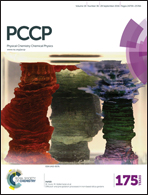Ultrafast electronic energy relaxation in a conjugated dendrimer leading to inter-branch energy redistribution†
Abstract
Dendrimers are arrays of coupled chromophores, where the energy of each unit depends on its structure and conformation. The light harvesting and energy funneling properties are strongly dependent on their highly branched conjugated architecture. Herein, the photoexcitation and subsequent ultrafast electronic energy relaxation and redistribution of a first generation dendrimer (1) are analyzed combining theoretical and experimental studies. Dendrimer 1 consists of three linear phenylene-ethynylene (PE) units, or branches, attached in the meta position to a central group opening up the possibility of inter-branch energy transfer. Excited state dynamics are explored using both time-resolved spectroscopy and non-adiabatic excited state molecular dynamics simulations. Our results indicate a subpicosecond loss of anisotropy due to an initial excitation into several states with different spatial localizations, followed by exciton self-trapping on different units. This exciton hops between branches. The absence of an energy gradient leads to an ultrafast energy redistribution among isoenergetic chromophore units. At long times we observe similar probabilities for each branch to retain significant contributions of the transition density of the lowest electronic excited-state. The observed unpolarized emission is attributed to the contraction of the electronic wavefunction onto a single branch with frequent interbranch hops, and not to its delocalization over the whole dendrimer.


 Please wait while we load your content...
Please wait while we load your content...